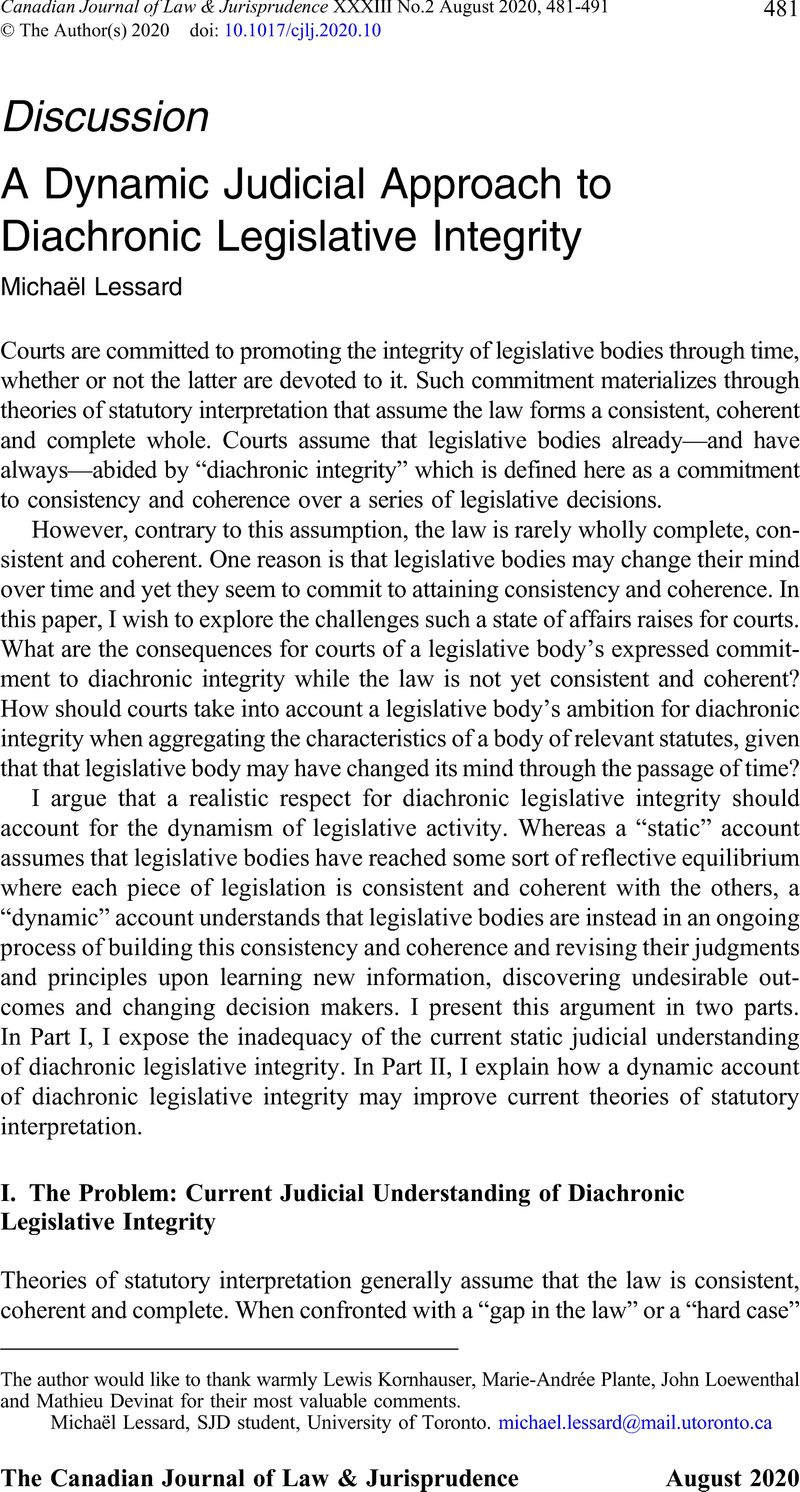Article contents
A Dynamic Judicial Approach to Diachronic Legislative Integrity
Published online by Cambridge University Press: 04 June 2020
Abstract

- Type
- Discussion
- Information
- Copyright
- © The Author(s) 2020
Footnotes
The author would like to thank warmly Lewis Kornhauser, Marie-Andrée Plante, John Loewenthal and Mathieu Devinat for their most valuable comments.
References
1. Pierre-André Côté with the collaboration of Stéphane Beaulac & Mathieu Devinat, Interprétation des lois, 4th ed (Thémis, 2009) 351-53 at para 1152; Pierre-André Côté with the collaboration of Stéphane Beaulac & Mathieu Devinat, The Interpretation of Legislation in Canada, 4th ed (Carswell, 2011) at para 1152.
2. As used in Lewis A Kornhauser & Lawrence G Sager, “The Many as One: Integrity and Group Choice in Paradoxical Cases” (2004) 32:3 Philosophy & Public Affairs 249; Christian List & Philip Pettit, “On the Many as One: A Reply to Kornhauser and Sager” (2005) 33:4 Philosophy & Public Affairs 377.
3. Kornhauser & Sager, supra note 2 at 255.
4. List & Pettit, supra note 2 at 253.
5. Ibid.
6. As exemplified in ibid at 270-71.
7. Ibid at 272.
8. Ibid.
9. List & Pettit, supra note 2 at 383 n 16.
10. Arts 523-37 CCQ.
11. Ibid, arts 523-29; Droit de la famille—20572, 2020 QCCA 585 at paras 23-27.
12. Art 530 CCQ; Droit de la famille—181478, 2018 QCCA 1120 at paras 54-59.
13. Ibid at para 124 (“Son nom l’indique, ce type de filiation unit en principe un enfant à ceux qui l’ont engender [reference omitted]”). See also paras 123-26 (seeing biological determination of parental status as the default position).
14. Ibid at para 54 (“La filiation par le sang, ce dont il est question ici, ne vise pas le lien génétique unissant l’enfant et le parent. Selon les articles 523 et 524 du Code civil du Québec, la « filiation par le sang » se prouve par l’acte de naissance ou encore par la possession constante d’état” [reference omitted]).
15. Thomas Kelly & Sarah McGrath, “Is Reflective Equilibrium Enough?” (2010) 24 Philosophical Perspectives 325, 334 (citing John Rawls); Thomas M Scanlon, “Rawls on Justification” in Samuel Freeman, ed, The Cambridge Companion to Rawls (Cambridge University Press, 2002) 141.
16. Norman Daniels, “Reflective Equilibrium” in Edward N Zalta, ed, The Stanford Encyclopedia of Philosophy (Stanford: Metaphysics Research Lab, 2018) 2.
17. Kelly & McGrath, supra note 15 at 332.
18. Scanlon, supra note 15 at 140-41.
19. Ibid at 140.
20. Ibid.
21. Ibid at 141.
22. As cited in Kelly & McGrath, supra note 15 at 329.
23. Daniels, supra note 16 at 3; Kelly & McGrath, supra note 15 at 334 (citing John Rawls).
24. Changes of decision makers may also be said to defeat the “No Contact with Reality” objection to the method of reflective equilibrium according to which “an individual might maintain a perfectly coherent set of beliefs while being completely unresponsive to relevant and easily perceptive changes in his or her environment.” See Kelly & McGrath, supra note 15 at 333. The perspective of a change of decision makers is a hanging Sword of Damocles compelling the decision makers to stay in touch with reality, or at least the reality of the ones who elect or nominate them.
25. Kelly & McGrath, supra note 15 at 335.
26. Scanlon, supra note 15 at 145.
27. This statement should not be understood as an opinion on American constitutional originalism. My point concerns the intensity versus the timing of a commitment to a principle. Originalism could be seen as such a principle. Both recent as well as intense acts of a legislative body could confirm commitment to originalism. Besides this clarification, one may wonder whether diachronic legislative integrity applies between a legislative body (such as Congress) and the body amending a constitution when this body is not the same (such as two-thirds of Congress and either the legislatures of three-quarters of the states or a state ratifying conventions in three-quarters of the states).
28. Ibid at 145-46.
- 2
- Cited by


